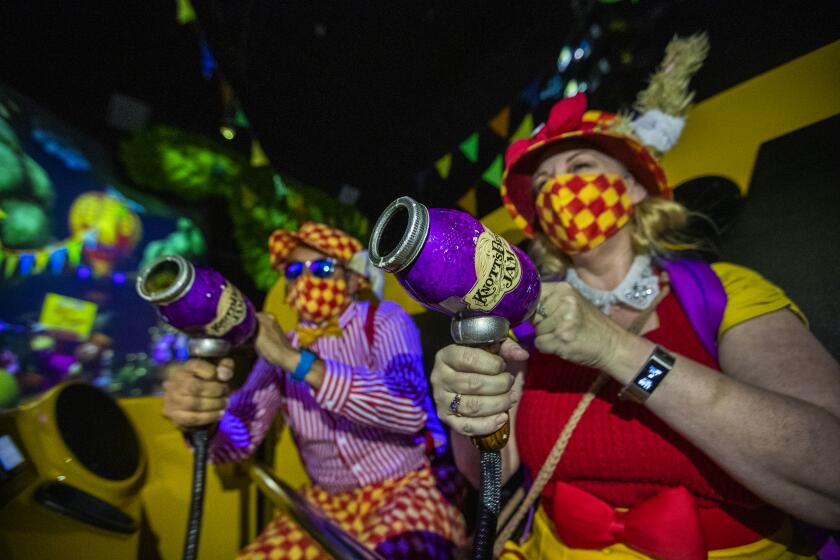Rolly Crump, Disney designer who helped define the look of Disneyland, dies at 93
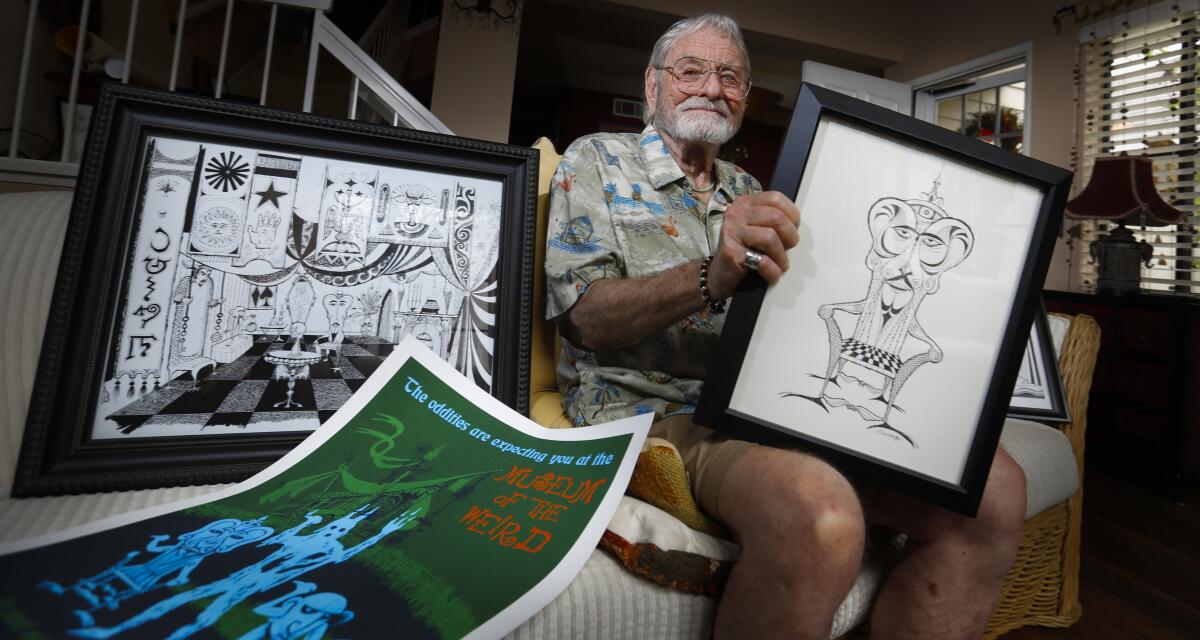
- Share via
Animator turned theme park designer Rolly Crump, who was instrumental in the design of early Disneyland, died Sunday in his Carlsbad home, where he had been in hospice care, said his son, Christopher. Crump was 93.
Crump received his big break at Walt Disney Co. in 1952, when he was 22.
Those at the animation studio liked to remind him that he was an oddball. “A diamond in the rough,” as Crump once proudly said he was labeled by a superior. Crump would later laugh, recalling — with swagger — that he was once told, “What you showed us was the worst portfolio of anyone ever hired in animation.”
Crump would go on to become one of the most important artists to work for Walt Disney Co.
It’s a Small World, the Enchanted Tiki Room and the Haunted Mansion are just a few of the projects Crump would contribute to once he joined Walt Disney Imagineering, known as WED Enterprises (for Walter Elias Disney) in 1959. With Imagineering, the division of the company that oversees Disney theme parks, Crump‘s designs would help define the look of Disneyland. The Anaheim park has been replicated in Florida and around the world and remains the backbone of Disney’s empire.
Like all of the core early stylists of what would become the great American theme park, Crump had never built a theme park before Disneyland. “Everything was so g— naive,” Crump once said, alluding to the fact that he carved the tikis of the Enchanted Tiki Room with plastic forks from the Disney commissary. The tikis still stand in the park today, and Crump’s designs — tiki gods and goddesses such as Pele, a fire goddess, and Hina Kaluua, a mistress of rain — continue to shape and influence tropical art.
The Disneyland Hotel’s wildly popular bar Trader Sam’s is steeped in the Crump influence. It was designed in his vision of tiki culture, which was based on weeks of research aided by anthropologist Katharine Luomala’s book “Voices on the Wind.” And to this day, Crump is heralded as co-leading what would become Disneyland’s greatest version of Tomorrowland, a sort of mod vision of future-past that opened in 1967.
Try as he might — and he’s tried countless times — Rolly Crump just can’t quit Disney.
Crump lacked a college degree, and his high school portfolio was untamed when he joined Disney’s animation department. His freewheeling, cartoonish drawings were more fit for a tattoo parlor than the mature works the esteemed animation house was seeking to create.
Although his animation credits — “Peter Pan,” “Lady and the Tramp,” “Sleeping Beauty” and “101 Dalmatians” — include some of the medium’s foundational texts, Crump wasn’t a star in the department. He worked primarily as an assistant to animation master Eric Larson and could spend the better part of a year on laborious but difficult tasks such as drawing the flexible dots on Dalmatians.
Yet his striking personal style, a brash use of color and a zest for the counterculture, not to mention a gutsy, determined drive, served Crump well. While in animation, the Alhambra-born artist surrounded himself with small but personal art projects — outlandishly painted rocks with beatnik-era slang and mini propellers and mobiles. Crump hung the latter in the animation department’s library, where he sneaked in what he called his “dopers,” that is, art that humorously celebrated drugs in the style of Beat generation barroom posters (“Be a man who dreams for himself,” read a painting cheerleading opium).

Crump continued to work on eccentric Pop art throughout his career at Disney. A comic strip-inspired 1967 poster for the psychedelic rock group the West Coast Pop Art Experimental Band belongs to the collection of New York’s Museum of Modern Art. His love affair with music was deeply present in his art, be it his bouyant portraits of jazz artist Josephine Baker, which were heavy on curves and ovals, like musical notes in flux, or the packaging he designed for Ernie Ball’s guitar strings. On such designs Crump’s exuberant line work and use of color feels free and loose, the illustrative equivalent of jazz improvisation.
“He had a way of doing outrageous art,” says retired Disney theme park designer Bob Gurr, known for conceptualizing many of Disneyland’s ride vehicles, including the original monorail. Gurr, 91, said he met Crump when the two were working on minor refurbishments in the 1950s for Mr. Toad’s Wild Ride at Disneyland, with Crump touching up some of the small red devils in the final scenes. Gurr immediately became a fan of Crump’s art and today owns some of Crump’s original “dopers.”
“He did these really sexy girls in very exotic sketching — pen and ink type stuff. You just looked at something and knew Rolly drew it. That’s just the way it was.”
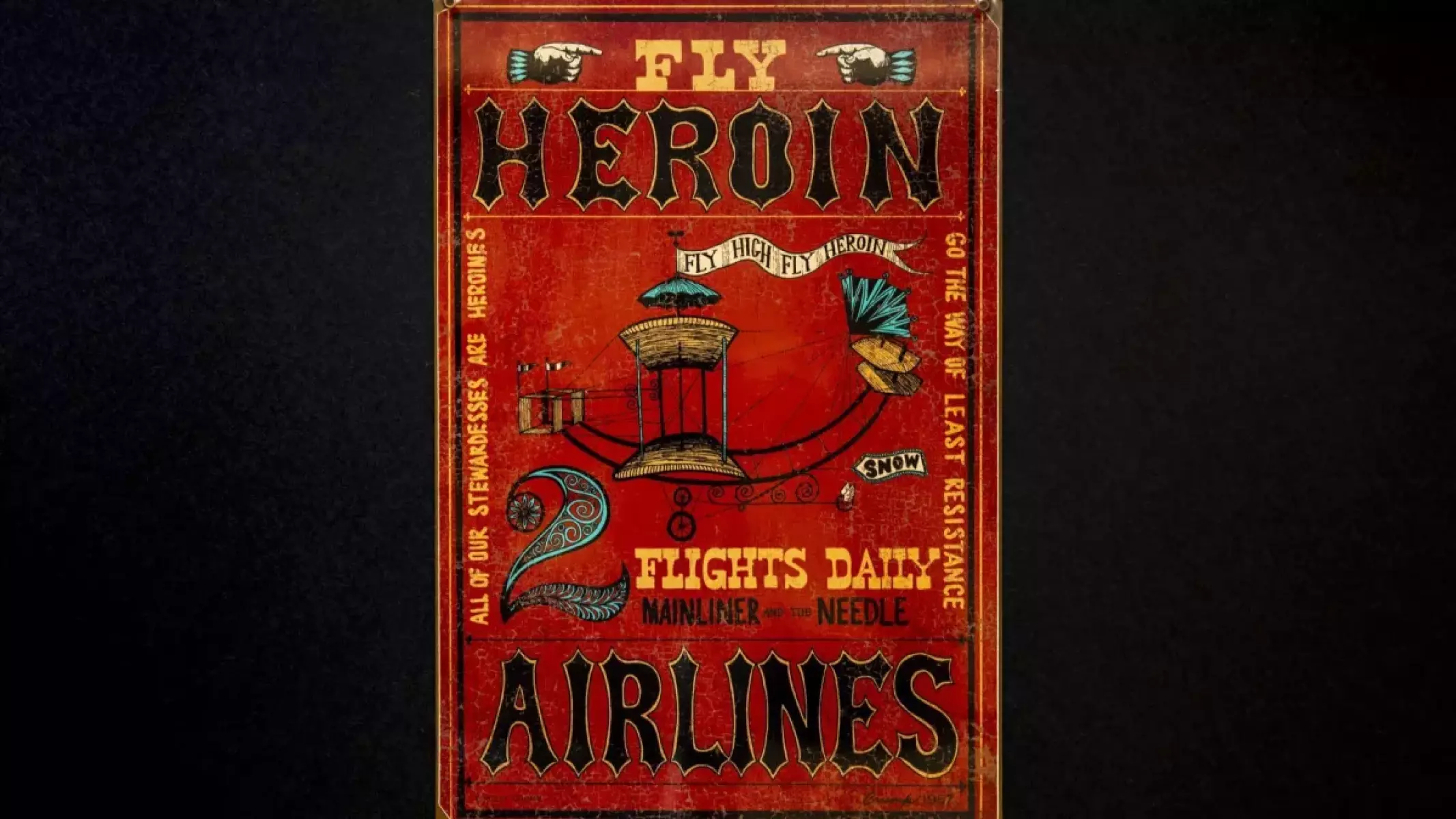
Crump’s art possessed a larger-than-life whimsy and circus-like loudness, and it caught the eye of Walt Disney, who plucked Crump from animation and one day assigned him what would become arguably the most recognizable clock in Southern California. The timepiece is the anchor of the facade of Disneyland’s It’s a Small World. Crump dreamed up a design, inspired by the art of Mary Blair, that was full of movement — numbers that looked caught mid-twist, and a face made of sun-like circles that was frozen with a delirious grin.
When Crump showed the design to his boss, Dick Irvine, it was marked for reassignment. Crump, however, went straight to the top. “I showed the clock to Walt and Walt said, ‘That’s good.’ Dick said, ‘It doesn’t have that European flavor.’ ... Walt looked Dick straight in the eye and said, ‘I like it the way it is.’ The old man backed me on so many damn things.”
His art was undoubtedly weird, yet only Sleeping Beauty Castle more instantly says Disneyland than the It’s a Small World facade. Whereas the park’s centerpiece is regal and pretty, the It’s a Small World sculpture is childlike and in possession of a wild fragility.
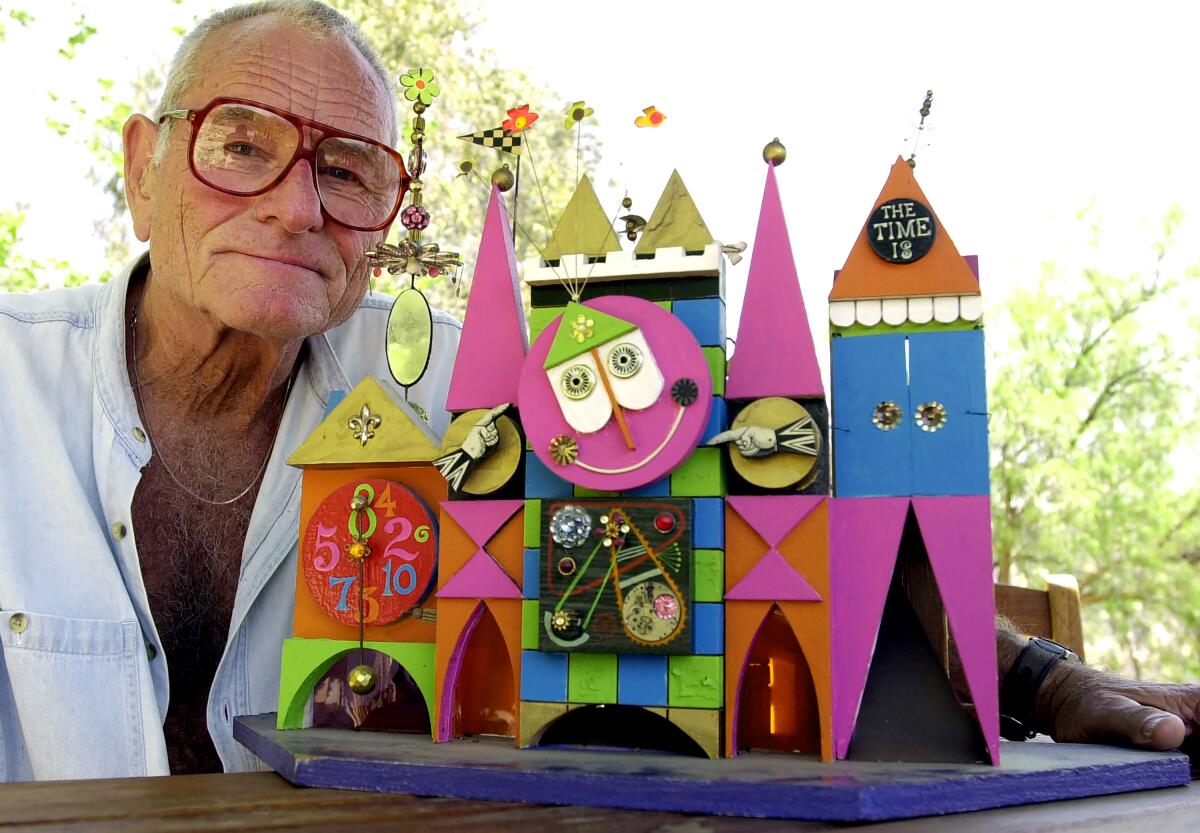
“He’s all risk,” said Doris Hardoon, who was recruited by Crump in the late ’70s for development of Walt Disney World’s Epcot, where the two worked on the creation of the Land Pavilion. “That’s his style. The way he thinks, the way dresses, the way he talks and the way worked with all of us.”
Tom Morris, who retired in 2016 after more than 35 years with Imagineering, called Crump “one of the greats.” “I would mimic his artwork as a kid, not even knowing there was a Rolly Crump,” Morris once told The Times. “There was just something I liked about the line work and the design of the tikis and the stage in Tomorrowland or parts of the Small World facade. I would just doodle those, and then later I found out Rolly was the guy who did all that, and I was like, ‘He was a god.’”
According to his son, Crump was a beatnik with a reputation as a rebel among the Disney fold. He was known to brag, for instance, about driving his Porsche around Disneyland’s Fantasyland when he served as Disneyland’s art director, one of many roles during his numerous stints with the company. He was also a fierce believer in theme parks as places of living art.
To the vocally blunt Crump — who was known, especially later in life, to send his peers bristling with his critiques — theme parks belonged to the artists who designed them rather than the companies that stewarded them. “Disneyland freaking hugs you and kisses you,” Crump declared in a 2018 interview with The Times in reference to the fact that the park was designed heavily by artists steeped in the art of animation, resulting in a handcrafted charm that he feared was gradually being lost to time.

Crump’s conflicted emotions only intensified in the years leading up to the opening of Florida’s Walt Disney World in 1971, which he worked on despite some misgivings.
“It had no feeling of Disney,” Crump says of Florida’s Magic Kingdom, noting it lacked the personal touch of animators trained in a hand-drawn craft. “It was a lot of good architectural pieces, but I looked at that and thought to myself, ‘What the hell is going on here?’ Disneyland has charm.”
Crump fought for Disneyland to retain a handcrafted quality. He was a no-nonsense, tell-it-like-it-is artist who was offended at the suggestion that others would be offended by his critiques. Crump, for instance, enjoyed a close relationship with Blair, the artist who designed the dolls for It’s a Small World and whose style informed the bulk of the interior of the attraction. An accomplished watercolorist and muralist, Blair, like Crump, was handpicked by Disney to transition out of animation and into theme park design.
Crump spoke to The Times in 2018 about, among many topics, the creation of It’s a Small World. Still an imposing, broad-shouldered figure in his then-late-80s, Crump was emphatic. “I had Mary’s sketches in a book and gave them to the model shop,” he said. “I said, ‘Whatever you design, make sure they look like these drawings.’ I was given the job of supervising It’s a Small World. I knew it was only going to work if everything looked like Mary Blair. As far as I was concerned, this is a Mary Blair ride. So off we went. The rest is history.”
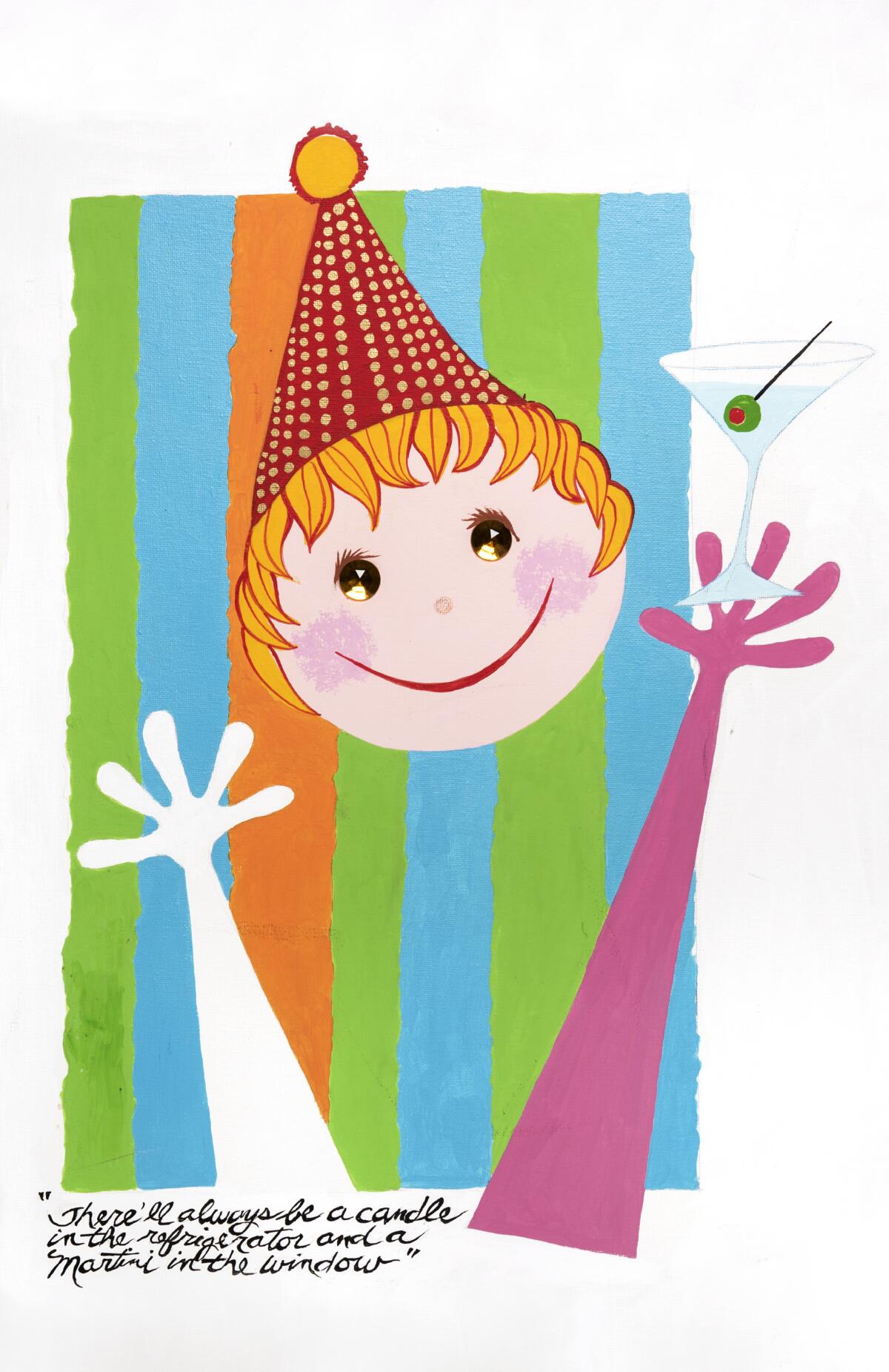
It was Crump’s fearlessness that allowed him to enjoy a close relationship with Disney, according to those who knew him. “They read each other so well,” said Gurr. “Behind their backs, a lot of people were upset. They said, ‘Walt likes Rolly best.’ We heard that all the time. Rolly never acted like he was kowtowing to the boss. He was himself around Walt, and I think Walt picked up on people who are very honest and not trying to play games. The two of them are so direct. A lot of other employees would try to be on their best behavior and try to get Walt’s attention, and Rolly just didn’t do any of that.”
An example: Before It’s a Small World landed at Disneyland, it was part of the 1964 World’s Fair, and Crump created a striking architectural piece he called the Tower of the Four Winds to accompany it. A series of mobiles — intertwined and overlapping — with a flaming sun in its center, the tower was modernist yet approachably innocent. Crump wasn’t happy with the final design, which had to be reinterpreted to withstand weather conditions. “It had been so overengineered,” said Crump. “It was fat looking. Walt said, ‘What do you think, Rolly? I said, ‘I think it’s a piece of crap.’”
Crump was born on Feb. 27, 1930, in Alhambra, but, as documented in his autobiography, “It’s Kind of a Cute Story,” written with author Jeff Heimbuch, Crump spent much of his childhood moving around, living at various points in Redlands, Eagle Rock and Santa Monica. Depression-era financial realities, as well as alcohol, took a toll on his parents’ marriage, and Crump was raised largely by his mother, Candice Elizabeth Ivie, who at one point worked as a secretary for 20th Century Fox. His daydreams were fueled by Disney’s “Silly Symphony” cartoons, in addition to other shorts of the time, as well as the art of his grandmother, who was trained at the Art Institute of Chicago.
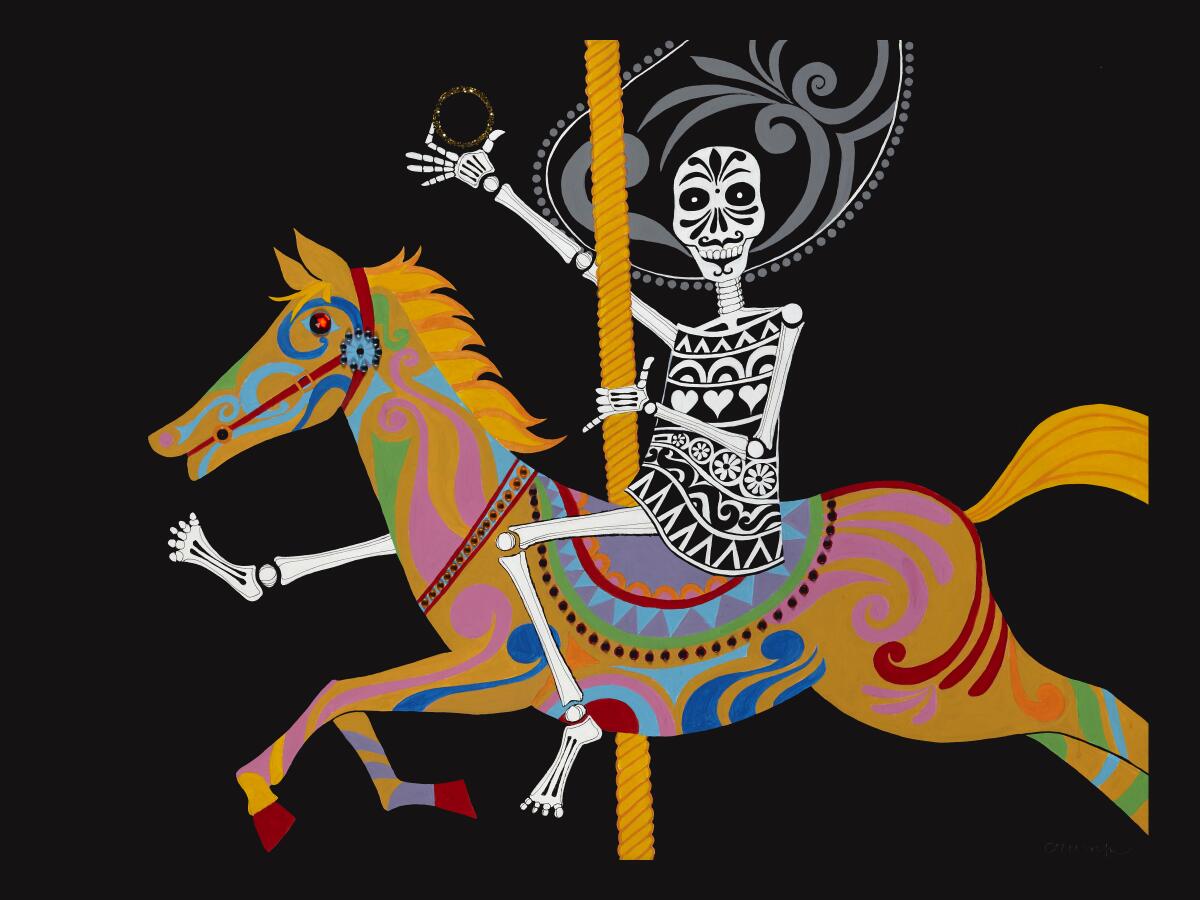
Crump’s love affair with Disney began at an early age. “I was 3 year’s old,” he told The Times. “My dad took me to see ‘The Three Little Pigs.’ He knew the projectionist so we got to go up into the projection booth. All that stuff stuck in my head. I don’t know if I was familiar with Disney at that time, but I immediately fell in love with Disney. I wanted to work for Disney. I wanted to draw and just be at Disney. I didn’t even know what animation was. I didn’t have a clue, and when they hired me, I don’t know why they hired me. I didn’t know where they were going to put me. All I knew is I wanted to work for Disney.”
He would get his wish, joining Disney’s animation house in 1952. Crump married his first of three wives, Leona Deiman, three years prior in 1949 and had a young daughter to support. Thus, he fought tirelessly to maintain his job as his animator’s salary didn’t pay the family bills. Crump, on evenings and weekends, would take on an assortment of work, from dipping at a ceramics factory to making manhole covers, but all the while he would continue to draw, sometimes even satirizing his own exhaustion in comic form.
“He’s very, very, very whimsical, and had a great sense of humor,” said retired Imagineer Steve Kirk, who worked with Crump on The Land and was instrumental in the creation of Epcot mascot Figment as well as the development of Tokyo’s DisneySea. “He had a tongue-in-cheek attitude about things. If you look at what he did for the Haunted Mansion, it’s just brilliant. I had a portfolio of his sketches that I looked at for inspiration.”
When he was officially brought to WED in 1959, Crump was assigned to work on a never-built “Wizard of Oz” area before being assigned the Haunted Mansion, working closely with illusion great Yale Gracey to develop initial ideas for the attraction. Many of the elaborate designs Crump and Gracey worked on didn’t make it into the final product, as in 1959 the Mansion was still thought of as a walk-through attraction rather than one with a ride vehicle, the Gurr-designed “doombuggies.”
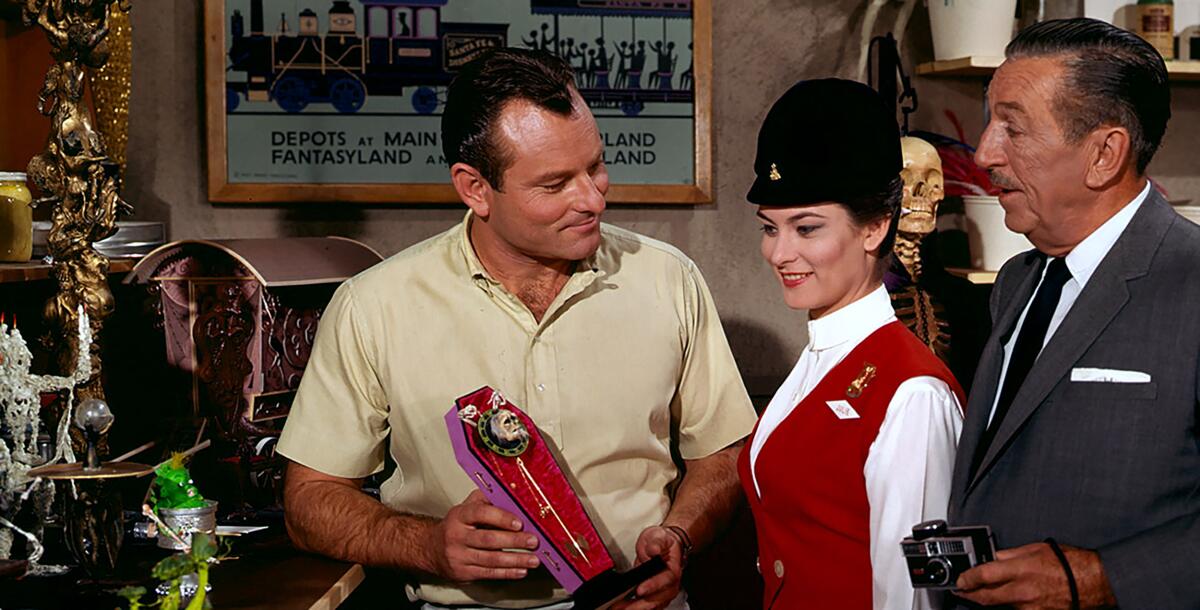
And yet, using glass, lighting and a bathtub, Gracey and Crump created as close to an origin story as one can find for the Mansion.
“The story was [that] the person who lived in there had been an old sea captain,” Crump told The Times in 2015. “He had killed his wife, bricked her up in the wall. Then he died at sea.
“The way Yale and I came up with it is that every now and again the ghost of the sea captain would come back and appear in his room. We did this illusion where he had the old slicker hat and coat, like he had been out in the ocean. We had him staged and reflected in the glass. He was standing in a shower. The water was coming down over the top of him and it was coming over the floor. It was a beautiful, beautiful illusion. Then we had her appear behind the brick wall, and she comes out screaming and attacks the sea captain. Then they both disappear.
“Thatwould have been one of the best illusions we could have ever shown,” Crump continued. Except it didn’t work if it needed to be repeated every few seconds. Still, Crump had a hand in the end result, as his designs inspired the menacing, wild-eyed wallpaper, interpreted by artist Tania Norris, that graces the Mansion.
Other Crump designs — a talking chair, a cauldron in a fireplace, demented, tarot-inspired flags and a melting candle man — remain part of Disney lore even if they didn’t make the finished product. For a time, the Haunted Mansion was going to include a so-called Museum of the Weird, which Crump was going to helm. But the idea, said former Imagineering leaders, died with Walt Disney in 1966. Still, Crump said some of his initial work was redrawn by other Imagineers — including an extremely early pass at the famed stretching room portraits, which were ultimately exquisitely crafted by Marc Davis.
“Yale came up with the idea of the stretch room because we had to build the Mansion outside the park,” Crump said. “In order to get over there, you had to take an elevator down to a lower level to get underneath the railroad tracks. Yale had developed the stretch room and I did some of the original concept paintings for the room. Marc Davis came in and said, ‘I hope you don’t mind, Rolly, but I’m going to redo the drawings because I don’t think what you did is any good.’ I laughed. I figured he’d do a better job, and he wasn’t afraid to let me know that.”
Kirk said some of Crump’s Mansion designs were “maybe too edgy.” “I used to keep a file of Disney characters for all the classics — style sheets,” Kirk said. “Rolly didn’t crib off of those. When he was designing something, it was all Rolly. It was all out of his head.”
Crump himself often spoke of the power of Disneyland’s appeal, crediting it to the idea that a core group of artists were constantly building off of one another’s designs rather than simply cribbing off established film and television creations. “I think the secret to Disneyland is that there are so many different designers that it became a wonderful melting pot of styles,” Crump said, as quoted in Jeff Kurtti’s book “Walt Disney’s Imagineering Legends.” “If you really look at that group within WED, and in Disneyland, you’ll see an incredible team. Walt seemed to know how to get the correct group of people together.”
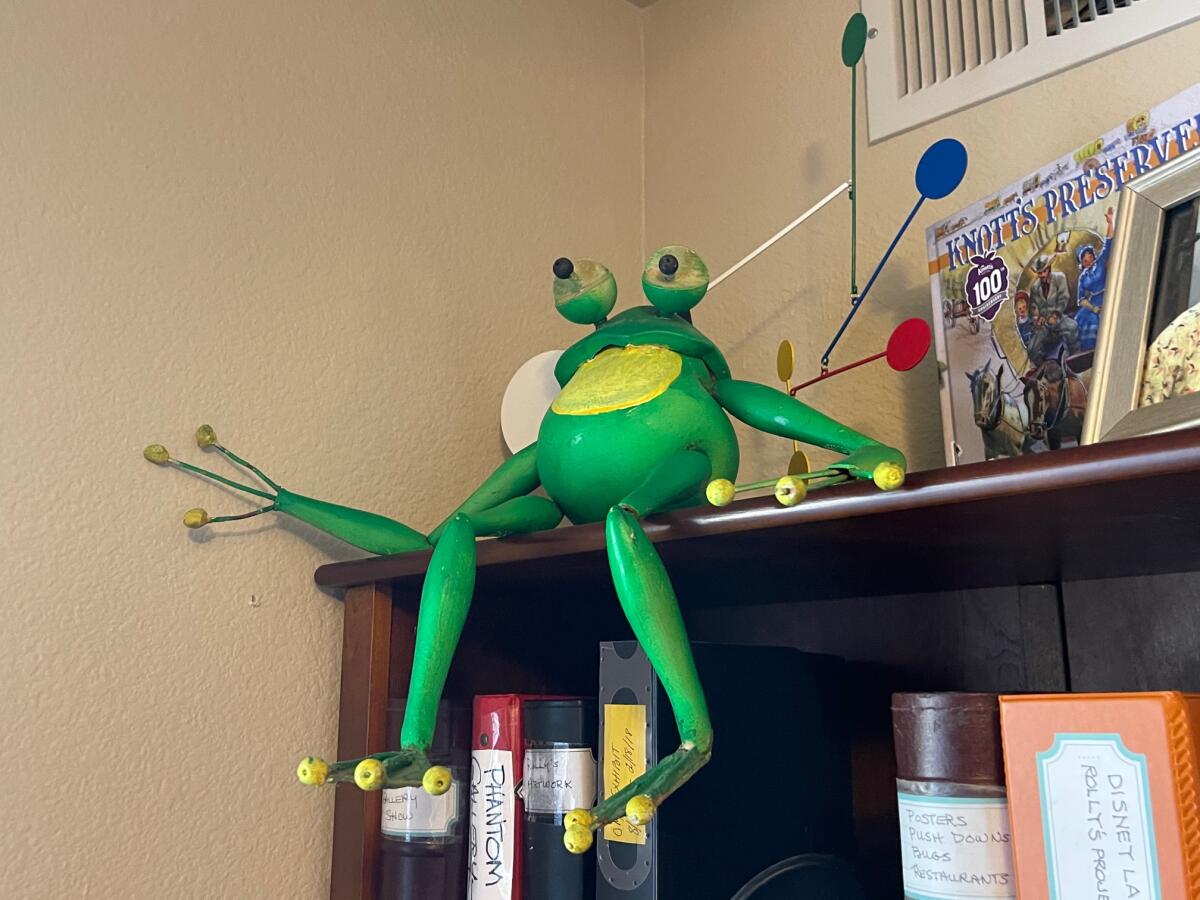
Crump left Disney in the ’70s to start his own design firm and contributed to other theme parks, including Knott’s Berry Farm. His Knott’s Bear-y Tales opened in July 1975 and represents a themed entertainment era when “intellectual property” wasn’t a marketing buzz phrase and a trippy ride could overflow with handcrafted dolls created from a single, haphazard sketch. Knott’s Bear-y Tales, with its sly fox selling Weird Juice (it will “make you feel weird!”) and its steampunk-inspired Chug-a-Chug pie-making assembly line, represented Crump’s whimsical-meets-beatnik-meets-rock ’n’ roll personality at its boldest.
Former Walt Disney Imagineer and theme park historian Christopher Merritt described in 2021 the ride’s grand finale to The Times: “In the middle of the room, there’s a big balloon coming from the ceiling where the Bear-y Family are going up and down, and there’s music, there’s Dr. Fox selling his Weird Juice, there’s puppets and there’s a frog jumping contest. There’s musicians, there’s a rabbit who’s walking on wire, there’s jugglers. It’s too much. It’s sensory overload.”
Crump’s influence can be seen in Knott’s Bear-y Tales: Return to the Fair, which opened in 2021. The newer ride is an adorable, video-game-like animated romp with cartoon critters and lots of pies — a respectful and nostalgic endeavor that livens up the park by celebrating its history.
Crump cemented his irreverent, unconventional style as a boss while working on the original Knott’s Berry Tales. When Crump was asked what it was like to be on his design team for Bear-y Tales, he started talking about booze, specifically giving it to his staff to unleash their creativity.

“I had this one kid who came from Disney, and he was a close friend of mine,” said Crump. “He loved beer. So I gave him his own office, and I would bring him as many six-packs as he wanted. I turned him loose. The stuff he came up with was absolutely incredible. Oh, God, that was fun. We were doing this by the seat of our pants.”
Crump returned to Disney and worked on various concepts for Walt Disney World’s Epcot, perhaps most notably helping to oversee the Land Pavilion. Where Crump went, stories follow, and his former peers often cite his cheeky office at Imagineering’s model shop. “He always had the funnest looking little spot — highly decorated,” said Gurr. “He had a medieval market umbrella decorated with funky art.”
“He was so much fun; his work space tented with Middle Eastern bedspreads, belting out jazz on his hi-fi and cooking his lunch on a hibachi,” said Disneyland’s current art director, Kim Irvine, who says she worked with Crump on multiple Walt Disney World projects, including that resort’s It’s a Small World and Enchanted Tiki Room. “We loved being part of it all.”
Irvine said Crump’s influence continues to affect the Disney parks, especially Disneyland, noting that as Walt Disney Co. became more global in its theme park pursuits, Crump helped form “a WED design group that would stay focused on Disneyland.”
“What an amazing designer, director and mentor he was,” Irvine remembers. “We all learned so much from him on our weekly walks through the park. After Rolly left, the team lived on to what is now a group of 40 and thriving. Several of us went to visit Rolly a couple years ago, to get his input on a project we were pursuing for Haunted Mansion. He was full of stories and ideas and gave us priceless advice.”
Hardoon, who was instrumental in the development of the castle at Shanghai Disneyland and the recently remade castle at Hong Kong Disneyland, said Crump is the biggest influence on her work. “I wouldn’t say I adopted his look, but it was transformative for me,” Hardoon said. “He does a lot of line work, and he puts color. That’s my thing too. It started making my brain think. He’s not a primary color guy. His color sense is close to my color sense. It’s not muddy.”
In 2004, Crump was initiated as a Disney “legend.” At first, he trashed the envelope, believing the company honor had become more about celebrity than saluting those who have shaped Disney history.
But he went, largely at the urging of his son and late Imagineering executive Marty Sklar. And then he proceeded to choke up onstage when he was presented with a window on Disneyland’s Main Street. Gurr was filming the moment and, recalling the day, laughed.
“In the course of discussing Walt Disney, he called him ‘brush mouth,’ because Walt had a mustache. It’s all in good heart. There’s no maliciousness,” Gurr said. “Rolly had an openness and an honesty that I seldom saw in anybody I ever worked with in any organization. That’s a Rolly characteristic. ... He and, I think, Mary Blair were two of Walt’s favorite artists.”
Crump is survived by his wife, Marie Tocci, and his children Christopher, Roxana and Theresa with his first wife, Leona Deiman. Crump has three grandchildren.
Beer and pantyhose helped famed designer Rolly Crump create a cult-status ride. Now Knott’s Bear-y Tales has inspired the park’s newest video game-like ride.
More to Read
The biggest entertainment stories
Get our big stories about Hollywood, film, television, music, arts, culture and more right in your inbox as soon as they publish.
You may occasionally receive promotional content from the Los Angeles Times.
